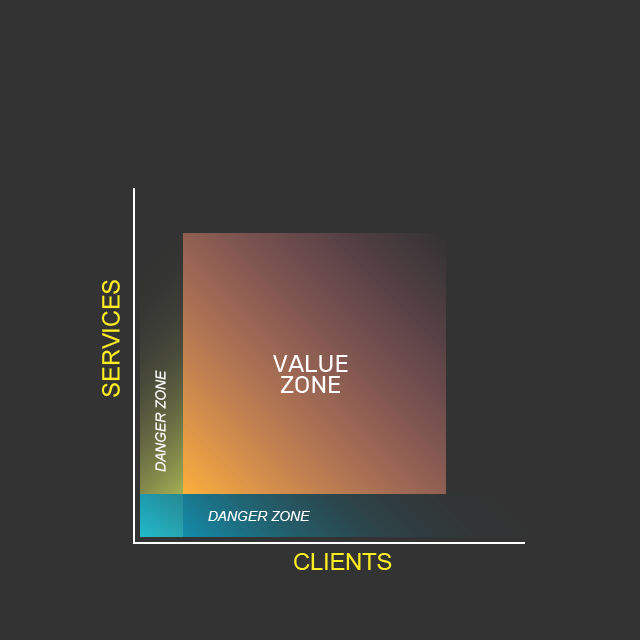
The difficulties between yesterday’s and tomorrow’s business models continue to exist in a struggle to find a balance. Companies who found their comfort zone are clashing against those who seek new horizons through innovation, but the disruptive element is still worrying old-school business models who found self-validation surviving through the Covid-19 pandemic.
A company works best balancing their services/clients ratio in a value zone that allows them to find fertile land to thrive. On the other hand, there are two danger zones to consider and also to avoid at all costs: A) too few services and many clients, B) too few clients and many services.
Case A starts with an old school imprint of business core decisions where the enterprise has been coasting for years, more likely over a decade where it found a cozy comfort zone that is in fact a danger zone. As markets and economies shift faster and faster, having only one or just a few services or products is harming any business activity. No restaurant offers one dish and one drink, so why should companies do that? Yes, some might claim “location”, yet until a competitor spawns right next to you, then your days are numbered.
Case B is where a company sets to make a difference too fast and too energetically forgetting to build first a solid and basic line of clients. Companies doing this are just showering their few accounts with too many services that will appear distracting to them, but more importantly, remove any focus from their business core. Despite the need of adapting to new scenarios, companies ought to develop one important primary asset to satisfy and make clients happy.
How to achieve the value zone? This target is not a precise point that requires unfathomable resources or time to obtain. The value zone is first accepting the fact there are danger areas to avoid, places to which are often taken for comfort zones. Once you raised awareness the following step is to admit mistakes were made, where the best solution to this problem is to accept the fact new strategies must be taken:
1) Do I have few services and many clients? Expect such service to be taken away from you by some competitor with better prices; or, expect the next economic turmoil that pushes politics and markets to pull the rug from beneath you.
2) Do I have few clients and many services? Expect such clients to run away because the lack of focus brings up the lack of experience and confidence; therefore you will provide average to below results as your energies and resources are spread on too many fronts. Less is sometimes more.
In the end, we can identify the value zone as a place where companies understand their potential through team work, being open-minded, but most importantly acknowledging times are changing faster and faster, that there no room for inside politics, pride, or ego.

